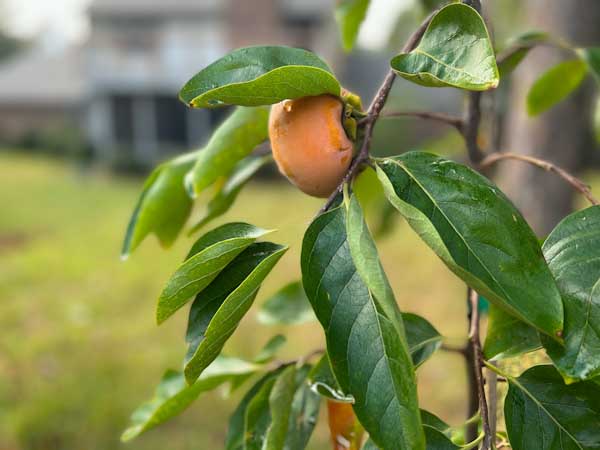
We may receive commissions from purchases made through links in this post, at no additional cost to you.
I love having something in my backyard orchard that’s just a little different from what you find at the neighbor’s place. That’s one of the goals of gardening, right? Persimmon trees fit into that category for me…at least for now. Growing (and eating) persimmons, especially Asian varieties like ‘Fuyu’, is increasing in popularity for good reason.
For those who want a persimmon tree, ‘Fuyu’ is the most popular cultivar for home gardens. It’s easy to grow, versatile, and delicious even to the pickiest palates. If you ever see a persimmon in the grocery store, chances are it’s a Fuyu. Unlike many other types of persimmon which need to be completely soft to be edible, Fuyu is ripe and sweet while it’s still firm.
However, as with just about every fruit, a home-grown Fuyu will taste infinitely better than anything you may find at the grocery store. Read on to learn all about how to plant, grow, harvest, and eat Fuyu persimmons.
Table of Contents
- All About Fuyu Persimmons
- Where to Plant a Fuyu Persimmon Tree
- Growing and Care
- Harvesting and Eating
All About Fuyu Persimmons
Persimmons are known as a “divine fruit” (a translation of the genus name Diospyros) for good reason. Their striking color, absurd sweetness, and ornamental foliage make them a desirable part of any garden.

‘Fuyu’ is a cultivar of the Asian persimmon (Diospyros kaki), which is native to China. This is a different species than the common American persimmon (D. virginiana) that you may find growing wild in the United States.
Related: American vs Asian Persimmons: What’s the Difference?
Asian persimmons were brought to America in the 1850s and have been successfully cultivated here ever since. The ‘Fuyu’ cultivar was introduced to the U.S. in the early 1900s from Japan, where it is now the national fruit and is an important part of Japanese culture.
China is the main producer of Fuyu persimmons worldwide, but they are also a successful commercial crop in California. Thankfully, these trees can thrive in many other places too, and they tolerate a wide variety of growing conditions.
How cold can a Fuyu persimmon tree tolerate?
Fuyu persimmons can be grown in USDA zones 7 to 11. They tolerate temperatures down to 0° F when dormant, but are much less cold-hardy during the growing season. Temperatures below about 27° F will kill leaves and young growth, potentially damaging the tree.
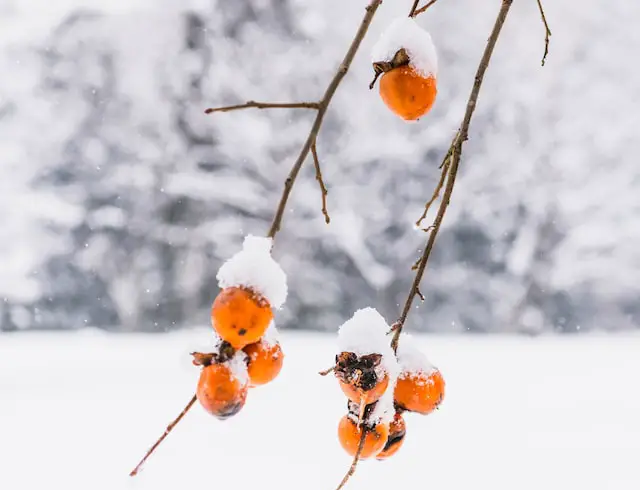
Since they are native to subtropical climates, Fuyus tolerate heat and humidity very well. They are deciduous trees, meaning they lose their leaves and go dormant in the winter. Growth begins again in spring based on heat units, as opposed to chill hours, so they don’t need a specific amount of cold to produce fruit.
This does mean, however, that unseasonably warm winter weather could trigger the plant to start growing too early. The tree may then be damaged by frost, potentially ruining the crop for an entire season. This isn’t likely to cause lasting problems for the tree, thankfully, and it should bounce back quickly.
What does a Fuyu persimmon taste like?
Fuyu persimmons are non-astringent and taste like a very sweet, but less acidic, apple or mango. They can be eaten when firm and crisp, or when slightly soft and juicy, like a plum. There also may be a hint of a pumpkin or sweet potato flavor in the background.
I prefer to eat Fuyus when they are a little softer and very juicy. They don’t need to be completely squishy and gelatinous like astringent persimmons do. Soft-ripe Fuyu persimmons still keep some bite, but they taste sweeter to me.
Related: Astringent vs Non-Astringent Persimmons: What’s the Difference?
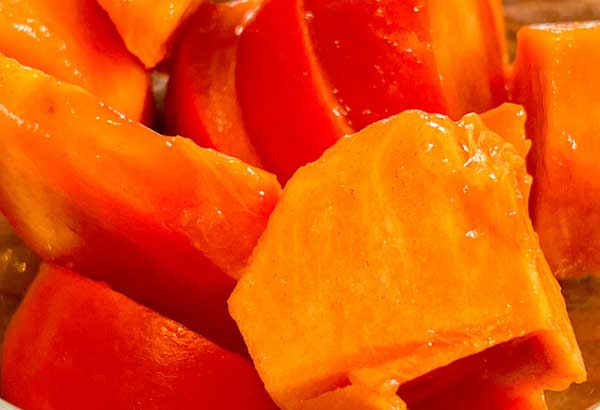
A still-crisp persimmon is also delicious and can be eaten right off the tree. The texture of the skin can be a little fibrous, so I prefer to peel mine before eating.
Do you need two Fuyu persimmon trees to bear fruit?
Fuyu persimmons are self-fruitful and will produce seedless fruit without pollination from another tree. A pollinated Fuyu persimmon will have seeds, but the fruit characteristics will be the same. Pollination could increase the size and quality of the harvest, but it is not necessary for fruiting.
Allowing the fruit to be pollinated could also prevent excessive fruit drop. Asian persimmon trees are prone to prematurely dropping fruit if under any stress due to extreme temperatures or water issues. Fruits that have been pollinated are less likely to drop before ripening.
Check out Persimmon Tree Pollination: Do You Need Two Trees? to learn more about how Fuyus (and many other types of persimmons) produce fruit. Some Asian persimmons are pollination-variant, meaning the color, flavor, and/or texture of the fruit may change if it has been pollinated. Fuyu persimmons are pollination-constant, meaning the fruit will look and taste the same regardless (other than having seeds).
Are Fuyu persimmon trees easy to care for?
Fuyu persimmon trees are very easy to grow and maintain. They are adaptable to many soil types, resistant to pests and disease, and drought-tolerant once established. Fuyu trees need full sun, well-drained soil, space to grow, and very little else to thrive.
There is no such thing as a maintenance-free fruit tree, but Fuyu persimmon may be as close as it gets. The best thing you can do to simplify caring for these trees is to choose the right location (more about this a little later in the article).
What does a Fuyu persimmon tree look like?
Expect a Fuyu persimmon tree to grow to about 15 to 20 feet tall and wide. You can keep the tree more compact by pruning it (see the pruning section below), which makes the fruit much easier to reach. Most Asian persimmons stay much smaller than the native American varieties, which can grow to be 50 to 80 feet tall.
Related: How Big Does a Persimmon Tree Grow?
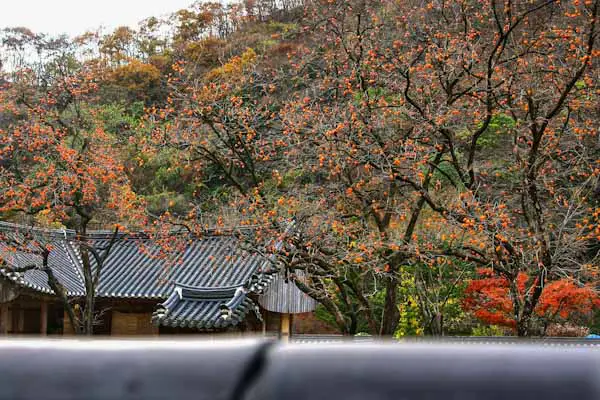
The foliage is deep green on top and a lighter green on the underside. The leaves are fairly large, veined, and slightly pointed at the tip. The fall color is spectacular, with the foliage becoming brilliant yellow-orange to red. Once the leaves fall, the ripening fruits become more visible and look like perfect orange-red ornaments on the bare tree.
In the spring, Fuyu’s blossoms are light yellow-green in color. They aren’t very showy from afar, since they blend in with the young leaves. But you may notice the large calyx (leaf-like petals at the base of the flower) that will become the characteristic green/brown leafy growth at the stem end of a ripe persimmon.
Where to Plant a Fuyu Persimmon Tree
Sun
Like most fruit trees, persimmons need to grow in full sun. Place your tree in an area that receives at least 6-8 hours of direct sunlight per day. Less sun exposure will lead to fewer persimmons, and the fruits will be smaller and less sweet.
In very hot climates, a little dappled shade in the afternoon can be a good thing. Some protection from the extreme heat of summer will cause the tree less stress, and may actually help the tree grow better.
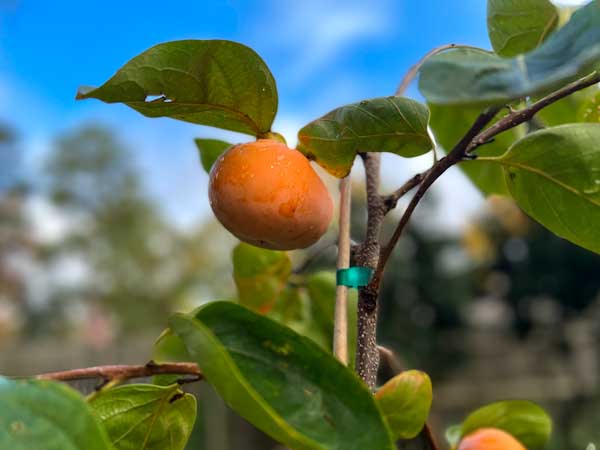
Soil
The ideal soil type for a Fuyu persimmon tree is well-drained, sandy loam with a pH between 6.0 and 6.5. But a Fuyu will grow well in less ideal conditions and also tolerates somewhat sandy or clay soil and a slightly wider pH range.
The most important thing is for the planting site to be well-drained. Fuyu persimmons do not like to grow in very heavy, soggy soil, which can cause root rot or other diseases. They need enough water retention to support fruit development, but not so much that the soil is constantly wet.
It’s a good idea to amend the soil with compost to improve drainage. When digging the hole at the planting site, mix in up to 50% of compost, peat moss (in sandy soil, to help with water retention), and/or pine bark with the native soil, then backfill the hole after planting.
Space
Fuyu persimmons need to be planted at least 15 feet apart in order to grow to their full size. Planting slightly closer (maybe 8 to 10 feet) can be a good strategy, however, if your goal is to limit the size of the tree. Just make sure the tree has space to spread its roots and get the nutrients it needs.
Read my article Planting a Persimmon Tree: Where, When, and How to Do It for complete information on choosing a growing site for your Fuyu persimmon.
Growing and Care
Water requirements
Young Fuyu persimmon trees need regular, deep watering, but be careful not to overdo it. Overwatering is a common cause of death to Fuyus. A good rule of thumb is to run the hose at a trickle for 10-20 minutes once or twice a week, especially during hot weather (and depending on rainfall). I like to use these watering bags, which release water slowly over about 8 hours.
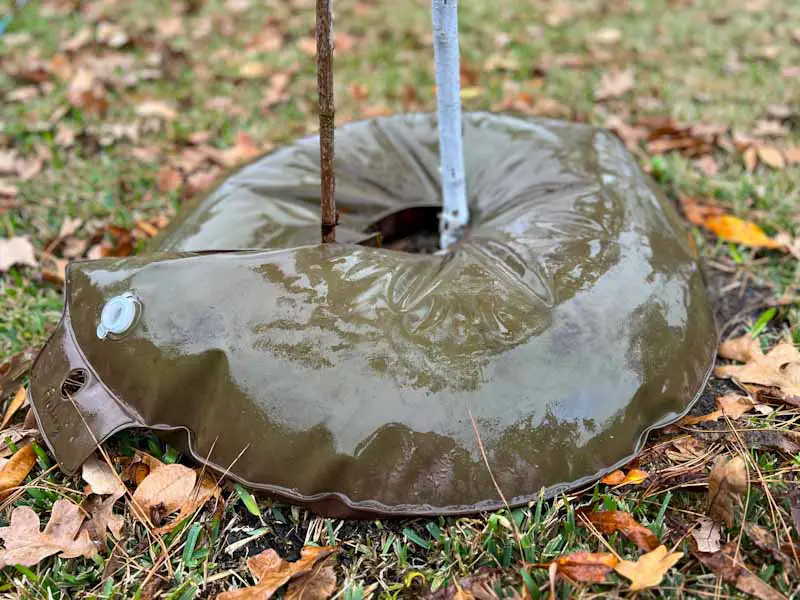
Persimmon trees need about 36 inches of water per year from rain and other irrigation. Once a Fuyu tree’s roots are established it can withstand short periods of drought. But be sure to provide some extra water during fruiting, otherwise the tree may drop its fruit due to stress.
Fertilizing
In fertile soil, a Fuyu persimmon may not need any fertilizer. Too much fertilizer could cause the tree to either produce too much leafy growth or to drop its leaves altogether. Excessive fertilizer can also cause the fruit to fall prematurely since the tree is putting energy toward supporting the canopy rather than the fruit. If your tree is growing well – about 12 to 24 inches per year – and the leaves are a deep green, then you can skip the fertilizer.
If, however, you notice that the leaves are pale, or that the growth is less than a foot per year, then your tree could benefit from some extra food. Fertilize the tree with an all-purpose slow-release, granular fertilizer (preferably organic) like this one in early spring. Areas with particularly lean soil may require another feeding or two in the summer.
It’s best not to fertilize at all when planting a Fuyu persimmon tree. Young persimmon tree roots can be very sensitive to fertilizer, so feeding at this time will probably cause more harm than good. Better to wait and see how the tree grows in your location before deciding to fertilize.
Pruning
Another reason Fuyu persimmons fall in the easy-to-care-for category is that they require little pruning. If you leave your tree unpruned, it will probably still grow and fruit quite happily. But even Fuyus can benefit from some moderate annual trimming, and your persimmon harvest will be even better for it.
Pruning will increase airflow and light exposure to the ripening fruit, allowing them to grow bigger and sweeter. You can also control the overall form and size of the tree. And even though it may seem counterintuitive, pruning will actually increase your persimmon crop, since the tree will be able to put more energy into producing fruit rather than supporting leafy growth.
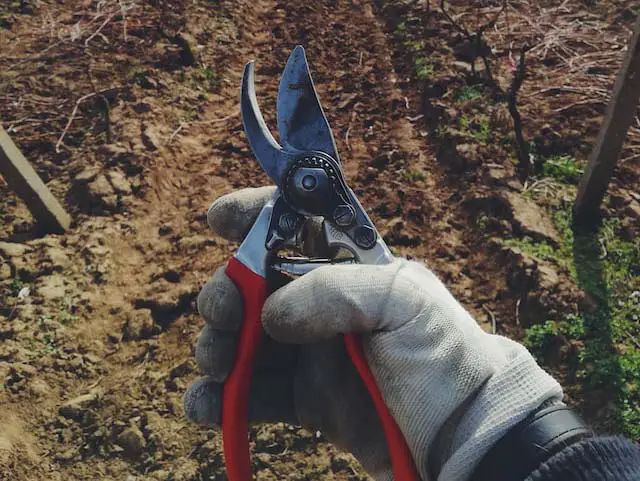
Most Fuyu persimmon pruning should be done while the tree is still dormant. Using sharp, disinfected pruners, trim off any dead, diseased, or damaged branches. Remove any root suckers near the base of the tree, and cut the longer branches back by about a third, if necessary.
To keep the tree compact, trim the topmost branches. Aim to keep most of the tree within reachable distance, to make harvesting easier. When the tree is young, you can cut the main leader (the central trunk) to about 4 or 5 feet, which will encourage lateral branch growth.
During the growing season, keep pruning to a minimum to avoid stressing the tree. But it’s always good to remove root suckers or water shoots (those straight-up branches with no fruit on them) whenever they appear. Also, go ahead and trim any damaged branches and diseased growth.
Thin the young persimmons so they are evenly spread on the branches. Persimmons become quite heavy as they mature, and too many ripening fruits may break the branch. You can skip this step, since the tree will most likely self-thin by dropping some of its fruit, but I find I have less branch breakage when I thin the fruit manually.
For more details on exactly how to prune persimmon trees, read Pruning an Asian Persimmon Tree in 5 Simple Steps.
Pests and Disease
Fuyu persimmon trees are fairly resistant to pest and disease problems. You may notice some leaf spot (also called anthracnose or leaf blight), characterized by tiny black dots on the leaves, but it rarely gets bad enough to warrant treatment. Crown gall, persimmon wilt, and root rot may also be issues.
Pests such as aphids, mealybugs, caterpillars, scale, persimmon trunk borer, and persimmon phylloxera could also show up. Again, healthy Fuyu trees are well-equipped to resist serious infestations, and a few pests shouldn’t affect the fruit or overall health of the tree.
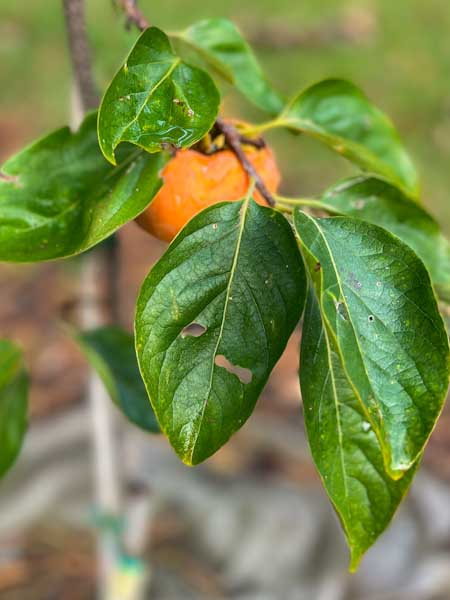
Wait until you notice an issue becoming more serious before you intervene. The best thing you can do is to contact your local county Extension Service to find out which pests and diseases tend to plague persimmon trees in your area. They will also give you information on how to treat problems, since each area will only allow certain fungicides and pesticides.
There are some simple things you can do to prevent the spread of leaf spot and other fungal diseases. Clean up fallen leaves and twigs around the tree, and keep the nearby area weed-free. Always thoroughly clean and disinfect pruners and other tools before use. Also, watering should be done early in the morning so the leaves have a chance to dry throughout the day.
Companion Plants
Often, the reason for selecting specific companion plants for a tree is to help ward off pests and other issues, or to attract pollinators. Since Fuyu persimmons rarely have serious pest problems and don’t need to be pollinated, that makes the job of choosing what to grow around it simple! They are tough trees that play well with just about any plant.
Once caveat though – make sure that there aren’t too many heavy-feeding plants close to the tree, especially if your soil is on the lean side. Nutrient competition with other plants could mean less growth and fewer persimmons.
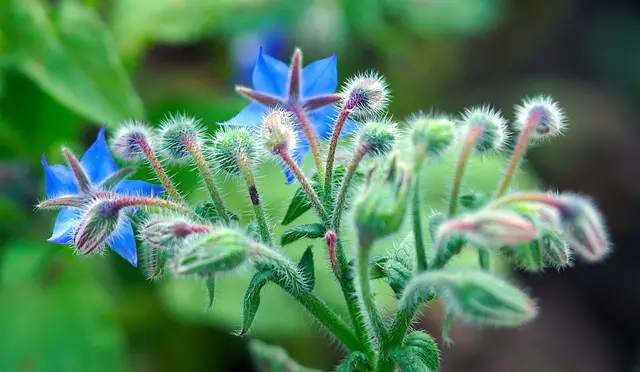
When in doubt, add a few of these tried-and-true, all-around good companion plants: borage, chives, comfrey, herbs, marigolds, and wildflowers. Try a creeping plant that could work as a living mulch, like sweet potato vine or strawberries.
Harvesting and Eating
How to Harvest Fuyu Persimmon
Harvesting your Fuyu crop is simple. Use pruners to clip the fruit stem just above the calyx (the leafy part at the top of the persimmon). The persimmons should still be firm, so stacking them in a basket won’t cause any bruising or fruit damage.
How to Tell if Fuyu Persimmon is Ripe
A ripe Fuyu persimmon will be bright orange to red-orange without a trace of green, and it will be about the size of an apple. It should feel firm, or with just a little give when gently squeezed (like a ripe avocado or peach). It’s okay to harvest Fuyus while they are still quite hard, as long as they’ve reached their mature size and color.
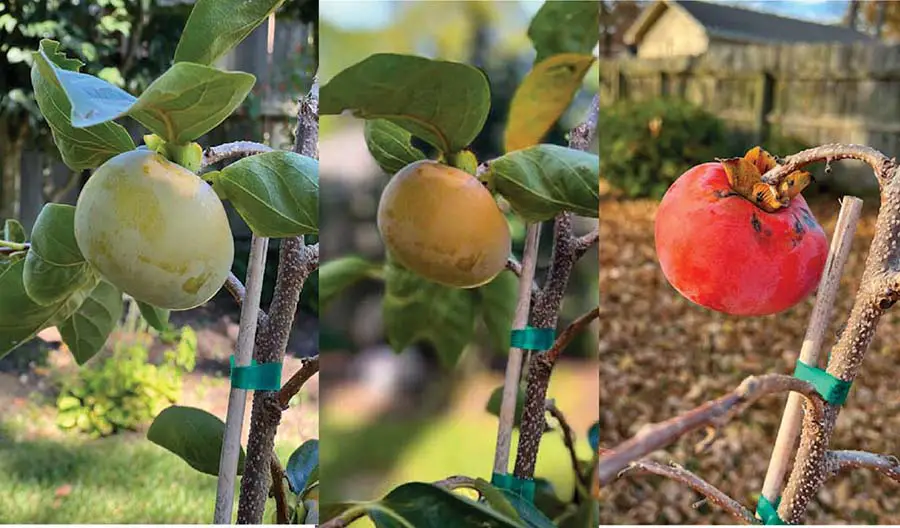
Fuyus will continue to soften after picking. Just place them on a counter for a week or so until they reach the desired texture. They will still taste very sweet when crisp and firm but will get juicier as they soften.
Related: When to Pick Persimmons: Including Harvesting Chart!
Preserving and Eating Fuyu Persimmon
One of the reasons Fuyu is the most popular persimmon in home gardens is because of its versatility. It can be eaten straight from the tree, peeled or unpeeled. A sliced, crisp Fuyu persimmon is perfect on a charcuterie board, in a salad, or by itself as a snack.
Fuyus can be dried whole as hoshigaki once the flesh is completely soft (although ‘Hachiya’ persimmons are traditionally used for drying this way). You can also slice the ripe fruit and use a food dehydrator. Make sure to wait until the persimmon is soft and juicy, though. A dried firm Fuyu is too tough and fibrous to enjoy.
Once it has softened, the flesh of Fuyu can be pureed and used in baked goods and desserts, just like a soft astringent variety. It is wonderful for jam, preserves, and persimmon butter. I like to freeze Fuyu persimmon pulp and add it to smoothies or pull it out whenever I want to use it for baking throughout the year.

